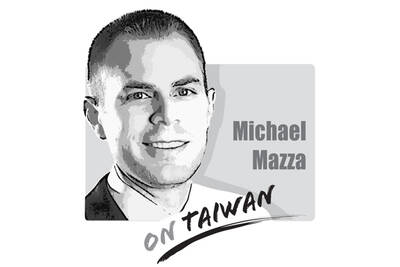Gregg Bergersen was a Navy veteran who liked to gamble on occasion but spent far more time worrying about how to earn serious money after he left his career as an analyst at the US Defense Department.
At 51 and supporting a wife and a child in the Virginia suburbs, he wondered how he could get himself cast in that distinctly Washington role that many Pentagon types dream of: a rewarding post-retirement perch at one of the hundreds of military-related companies that surround the capital and flourish off lucrative government contracts and contacts.
Bergersen believed he had found what he was seeking when he was introduced to Kuo Tai-shen (郭台生), a native of Taiwan, who had lived in New Orleans for more than 30 years. Kuo, an entrepreneur who imported furniture from China, was active enough in civic affairs to have been named to a state advisory board on international trade. He told Bergersen that he was developing a defense consulting company.

Bergersen was sentenced to 57 months in prison on Friday, while Kuo and a third accomplice are awaiting sentencing in a federal court for their involvement in one of many cases brought in the last year involving the illegal transfer of information to China.
The cases have intensified the evaluation in intelligence and law enforcement circles about the breadth of the threat from Beijing. Many have been similar to the one involving Bergersen, in that prosecutors describe them as carefully planned intelligence operations run by the Chinese government intended to steal national security secrets. Other cases, however, are less clear in their nature; some seem to be closer to violations of commercial export laws, with the transferred information designed to provide Chinese companies with a technological benefit.
Court papers and interviews indicate that Kuo and his Chinese handlers ran what intelligence professionals call a “false flag” operation on Bergersen, a weapons systems analyst, making him believe that the information he was providing was going to Taiwan, a US ally, and not to Beijing.
Nonetheless, surveillance tapes made by the FBI showed that Bergersen understood he was engaged in a serious crime.
While sitting in a rental car on July 10 last year, Bergersen pleaded with Kuo not to tell anyone that he was the source of the information he was providing, which included anticipated US arms sales to Taiwan.
“I’d get fired for sure on that,” he said. “Well, not even get fired, go to [expletive] jail.”
While Bergersen may have convinced himself that the offense was attenuated because the information was going to Taiwan, the recordings show he took the risk mainly because Kuo regularly dangled a promise that he would eventually take him in as a partner in a defense consulting firm after he retired from the Pentagon and pay him US$300,000 to US$400,000 a year. In the meanwhile, Kuo gave him small gifts and took him to Las Vegas, where he treated him to expensive shows and paid for his wagering, all of which were observed by FBI agents.
Beyond the case of Bergersen, prosecutors in the last year brought about a dozen cases involving China’s efforts to obtain military-grade accelerometers — used to make smart bombs — defense information about Taiwan, US warship technology, night-vision technology and refinements to make missiles more difficult to detect.
In interviews, current and former intelligence and law enforcement officials demonstrated uncertainty as to the precise scope of the problem of Chinese espionage. But many officials offered a similar description of the pattern of the cases: the Chinese government and state-sponsored industries have relied on the Chinese diaspora — using immigrants, students and people of second and third-generation Chinese heritage — and regular commercial relations to operate a system in which people wittingly or unwittingly participate.
One senior law-enforcement official involved in prosecuting such cases said the Chinese had “a game plan of sending out lots of tiny feelers in hopes of getting back small bits of seemingly unrelated information in hopes of creating a larger picture.”
David Szady, who as an assistant director of the FBI ran its counterintelligence division until retiring in 2006, said the Chinese had “mastered the use of multiple redundant collection platforms” by looking for students, delegates to conferences, relatives and researchers to gather information.
Federal investigators have come to believe, Szady said in an interview, that while the collection system may appear haphazard, even random, the Chinese “have become very focused on what they want.”
Officials said that several other nations, notably Iran and Russia, had aggressively engaged in espionage aimed at the US. But Joel Brenner, the intelligence community’s top counterintelligence official, said China was by far the leading practitioner.
In an interview, Brenner described China’s information-gathering efforts as “a full-court press and relentless.”
As a result, he said, few professional analysts “really think that what’s going on is anything other than an orchestrated, deeply thought-out, strategic campaign.”
But, Brenner said, not all the information-transfer cases involving China are part of that suspected government-led espionage effort.
“Some instances are purely commercial and just involve greed,” he said.
On the military side, Brenner said, China was especially interested in improving its naval capability against any threat from the US and obtaining any intelligence that might be important in a military confrontation in the Taiwan Strait.
In one case, he noted, China was trying to obtain technology to help its submarines run quieter and avoid detection.
One clue as to the degree of coordination of some of the operations is buried in court papers in the Bergersen case. According to one FBI document, the mastermind was an unnamed Chinese government official based in both Hong Kong and Guangzhou. The official, identified only as “PRC official A,” is described by people familiar with the case as a senior Chinese intelligence official who had also been a central figure in two other recent Chinese espionage operations.
PRC official A, these people said, had also helped coordinate the activities of Mak Chi, a Chinese-born engineer who was sentenced in March to more than 24 years in prison for selling naval secrets to China. The information was not classified, Mak’s lawyers argued at trial, although it was illegal to provide it to China.
Brenner noted testimony showing that Mak was a “sleeper agent” who worked his way up in the military contracting industry, which he said “bespeaks a patience that the Chinese are especially good at.”
At the trial, prosecutors presented a “tasking list” from Chinese government handlers that set forth a catalog of naval information Mak was to obtain.
“You can get to know the dragon by its claw and the list was a clear picture of the dragon’s claw,” Brenner said.
Mak and PRC official A also figure in a third major case involving Chung Dongfan.
Chung, a former Boeing engineer known as Greg, was convicted on economic espionage charges for providing China with company trade secrets related to several aerospace programs, including the space shuttle.
The documents say Chung decided to spy for China partly out of patriotic sentiment. A letter from a Chinese official to Chung said “it is your honor and China’s fortune that you are able to realize your wish of dedicating yourself to the service of your country.”
The appeal to ethnic loyalty raises the sensitive issue of whether the authorities have reason to be more suspicious of Chinese researchers and students. Lee Wen Ho (李文和), a former scientist at Los Alamos National Laboratory was arrested in 1999 on 59 counts involving espionage and China. All but one of the charges was dropped after a judge found significant problems with the government’s case.
Lee and many supporters contended that he had been unfairly singled out because of his Chinese heritage. He eventually received a settlement from the government and from several news outlets, including the New York Times, that had reported the early suspicions.
Steven Pelak, the export enforcement coordinator in the counterespionage section of the Justice Department, said there was an inherent protection against resorting to profiling or stereotyping. Almost all of the department’s cases involving suspected Chinese espionage, Pelak said, come from companies that report a commercial inquiry or request that seems suspicious and not through surveillance because someone has Chinese heritage or connections.
It is also impracticable to keep track of Chinese visitors to the US, since they number about 600,000 a year, in addition to 60,000 students in the US at any one time.
Chinese intelligence officials apparently believed that the Kuo-Bergersen channel had enough potential to assign a professional intelligence officer to live in New Orleans to act as a “cut-out,” or intermediary, between Kuo and PRC Official A. That person was Kang Yuxin (康玉新), a 33-year-old woman who was the third accomplice charged in the case.
Kuo was provided US$50,000 by his Chinese handlers, which he used largely to get close to Bergersen by paying for trips, restaurant meetings and small gifts. At one point, FBI surveillance tapes showed, Bergersen recounted how his wife discovered a large wad of cash he had received from Kuo. Thinking quickly, Bergersen told her it was gambling winnings from a European trip. To his dismay, she said she was entitled to half and took it. After Bergersen related this bit of ill-fortune, Kuo offered to compensate him for the difference, but Bergersen declined.
Kuo and Kang, scheduled for sentencing later this summer, face life in prison.
ADDITIONAL REPORTING STAFF REPORTER

Taiwan has lost Trump. Or so a former State Department official and lobbyist would have us believe. Writing for online outlet Domino Theory in an article titled “How Taiwan lost Trump,” Christian Whiton provides a litany of reasons that the William Lai (賴清德) and Donald Trump administrations have supposedly fallen out — and it’s all Lai’s fault. Although many of Whiton’s claims are misleading or ill-informed, the article is helpfully, if unintentionally, revealing of a key aspect of the MAGA worldview. Whiton complains of the ruling Democratic Progressive Party’s “inability to understand and relate to the New Right in America.” Many
US lobbyist Christian Whiton has published an update to his article, “How Taiwan Lost Trump,” discussed on the editorial page on Sunday. His new article, titled “What Taiwan Should Do” refers to the three articles published in the Taipei Times, saying that none had offered a solution to the problems he identified. That is fair. The articles pushed back on points Whiton made that were felt partisan, misdirected or uninformed; in this response, he offers solutions of his own. While many are on point and he would find no disagreement here, the nuances of the political and historical complexities in
Taiwan is to hold a referendum on Saturday next week to decide whether the Ma-anshan Nuclear Power Plant, which was shut down in May after 40 years of service, should restart operations for as long as another 20 years. The referendum was proposed by the opposition Taiwan People’s Party (TPP) and passed in the legislature with support from the opposition Chinese Nationalist Party (KMT). Its question reads: “Do you agree that the Ma-anshan Nuclear Power Plant should continue operations upon approval by the competent authority and confirmation that there are no safety concerns?” Supporters of the proposal argue that nuclear power
The Centers for Disease Control and Prevention (CDC) earlier this month raised its travel alert for China’s Guangdong Province to Level 2 “Alert,” advising travelers to take enhanced precautions amid a chikungunya outbreak in the region. More than 8,000 cases have been reported in the province since June. Chikungunya is caused by the chikungunya virus and transmitted to humans through bites from infected mosquitoes, most commonly Aedes aegypti and Aedes albopictus. These species thrive in warm, humid climates and are also major vectors for dengue, Zika and yellow fever. The disease is characterized by high fever and severe, often incapacitating joint pain.